View in other NatureServe Network Field Guides
NatureServe
Montana
Utah
Wyoming
Idaho
Wisconsin
British Columbia
South Carolina
Yukon
California
New York
Fernleaf Desert-parsley - Lomatium multifidum
Other Names:
Fernleaf Biscuitroot,
Lomatium dissectum, Lomatium multifidum var. multifidum
Native Species
Global Rank:
G4
State Rank:
S3S4
(see State Rank Reason below)
C-value:
6
Agency Status
USFWS:
USFS:
BLM:
External Links
State Rank Reason (see State Rank above)
This species occurs over a wide area of northwest Montana, where it grows on open talus, bedrock and scree. It may over time be vulnerable to displacement by Centaurea maculosa or losses from herbicide spray and drift. Lomatium dissectum is currently not rare, but its status should be reviewed periodically (each 10 years?).
General Description
Plants caulescent. Stems ascending, 15–100 cm from a mostly simple caudex. Herbage glabrous to puberulent, mildly aromatic. Leaf blades 8–25 cm long, broadly ovate, 3 to 4 times pinnately divided; ultimate segments crowded, linear, 2–8 × ca. 1 mm. Umbels: peduncles 8–50 cm; rays ca. equal 2–6 cm long; involucel bracts linear 5–15 mm long. Flowers yellow. Mericarps glabrous, elliptic, 7–13 mm long, marginal wings ca. 0.5 mm long; oil tubes inconspicuous (
Lesica et al. 2012. Manual of Montana Vascular Plants. BRIT Press. Fort Worth, TX).
Our plants are variety
multifidum (Nutt.) Mathias & Constance
Diagnostic Characteristics
Lomatium dissectum should not easily be confused with other Lomatium species in Montana. It could be mistaken with Ligusticum filicinum or L. tenuifolium, which tend to grow in more mesic habitats. Lomatium dissectum has either yellow or purplish flowers while Ligusticum flowers are white.
Species Range
Montana Range
Range Descriptions
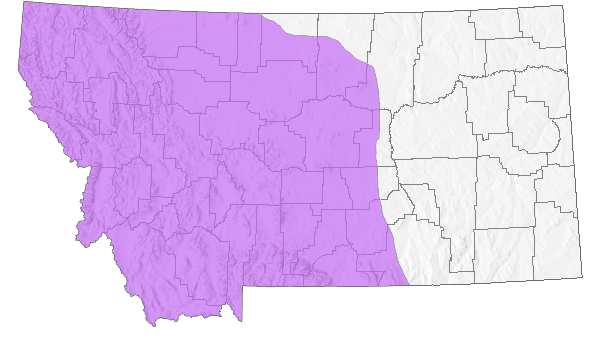
 Native
Native
Range Comments
Lomatium dissectum var. dissectum occurs in, and west of, the Cascade Range and in northern Idaho. Variety multifidum occurs in south British Columbia and to northern Wyoming, central Idaho and central Oregon and less commonly to northern Nevada and southern Idaho. It has also been reported to occur through California to Baja California (Hickman, 1993). Variety eatonii occurs from southern Wyoming, southern Idaho and central and northeastern Oregon, Colorado, Nevada and southern California (Cronquist et al, 1997). A distribution map for Lomatium dissectum is provided on the internet (see citation list).
Observations in Montana Natural Heritage Program Database
Number of Observations: 379
(Click on the following maps and charts to see full sized version)
Map Help and Descriptions
Relative Density
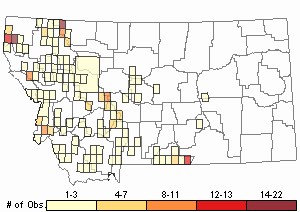
Recency
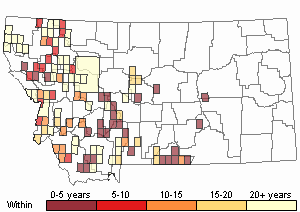

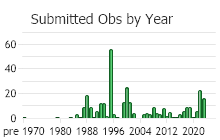
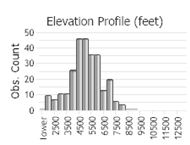 (Observations spanning multiple months or years are excluded from time charts)
(Observations spanning multiple months or years are excluded from time charts)
Habitat
Stony soil of open slopes, grasslands, thickets, open forest; valleys to lower subalpine (
Lesica et al. 2012. Manual of Montana Vascular Plants. BRIT Press. Fort Worth, TX).
Stewardship Responsibility
References
- Literature Cited AboveLegend:
 View Online Publication
View Online Publication Lesica, P., M.T. Lavin, and P.F. Stickney. 2012. Manual of Montana Vascular Plants. Fort Worth, TX: BRIT Press. viii + 771 p.
Lesica, P., M.T. Lavin, and P.F. Stickney. 2012. Manual of Montana Vascular Plants. Fort Worth, TX: BRIT Press. viii + 771 p.
- Additional ReferencesLegend:
 View Online Publication
View Online Publication
Do you know of a citation we're missing? Ament, R.J. 1995. Pioneer Plant Communities Five Years After the 1988 Yellowstone Fires. M.Sc. Thesis. Bozeman, MT: Montana State University. 216 p.
Ament, R.J. 1995. Pioneer Plant Communities Five Years After the 1988 Yellowstone Fires. M.Sc. Thesis. Bozeman, MT: Montana State University. 216 p. Clark, D. 1991. The effect of fire on Yellowstone ecosystem seed banks. M.Sc. Thesis. Montana State University, Bozeman. 115 pp.
Clark, D. 1991. The effect of fire on Yellowstone ecosystem seed banks. M.Sc. Thesis. Montana State University, Bozeman. 115 pp. Forcella, F. 1977. Flora, chorology, biomass and productivity of the Pinus albicaulis-Vaccinium scoparium association. M.S. Thesis. Bozeman, MT: Montana State University. 99 pp.
Forcella, F. 1977. Flora, chorology, biomass and productivity of the Pinus albicaulis-Vaccinium scoparium association. M.S. Thesis. Bozeman, MT: Montana State University. 99 pp. Lesica, P., M.T. Lavin, and P.F. Stickney. 2022. Manual of Montana Vascular Plants, Second Edition. Fort Worth, TX: BRIT Press. viii + 779 p.
Lesica, P., M.T. Lavin, and P.F. Stickney. 2022. Manual of Montana Vascular Plants, Second Edition. Fort Worth, TX: BRIT Press. viii + 779 p. Martinka, R.R. 1970. Structural characteristics and ecological relationships of male blue grouse (Dendragapus obscurus (Say)) territories in southwestern Montana. Ph.D Dissertation. Bozeman, MT: Montana State University. 73 p.
Martinka, R.R. 1970. Structural characteristics and ecological relationships of male blue grouse (Dendragapus obscurus (Say)) territories in southwestern Montana. Ph.D Dissertation. Bozeman, MT: Montana State University. 73 p. Quire, R.L. 2013. The sagebrush steppe of Montana and southeastern Idaho shows evidence of high native plant diversity, stability, and resistance to the detrimental effects of nonnative plant species. M.Sc. Thesis. Bozeman, MT: Montana State University. 124 p.
Quire, R.L. 2013. The sagebrush steppe of Montana and southeastern Idaho shows evidence of high native plant diversity, stability, and resistance to the detrimental effects of nonnative plant species. M.Sc. Thesis. Bozeman, MT: Montana State University. 124 p. Seipel, T.F. 2006. Plant species diversity in the sagebrush steppe of Montana. M.Sc. Thesis. Bozeman, MT: Montana State University. 87 p.
Seipel, T.F. 2006. Plant species diversity in the sagebrush steppe of Montana. M.Sc. Thesis. Bozeman, MT: Montana State University. 87 p. Simanonok, M. 2018. Plant-pollinator network assembly after wildfire. Ph.D. Dissertation. Bozeman, MT: Montana State University. 123 p.
Simanonok, M. 2018. Plant-pollinator network assembly after wildfire. Ph.D. Dissertation. Bozeman, MT: Montana State University. 123 p. Simanonok, M.P. and L.A. Burkle. 2019. Nesting success of wood-cavity-nesting bees declines with increasing time since wildfire. Ecology and Evolution 9:12436-12445.
Simanonok, M.P. and L.A. Burkle. 2019. Nesting success of wood-cavity-nesting bees declines with increasing time since wildfire. Ecology and Evolution 9:12436-12445.
- Web Search Engines for Articles on "Fernleaf Desert-parsley"





